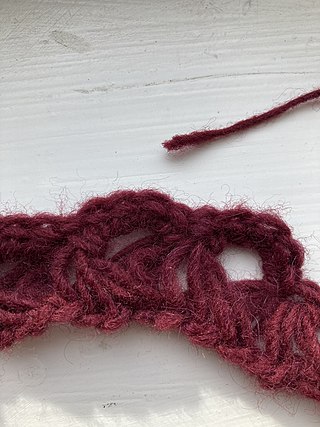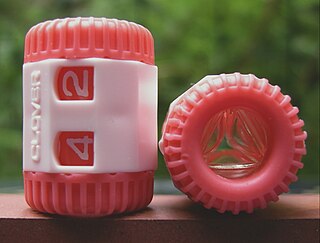
Crochet is a process of creating textiles by using a crochet hook to interlock loops of yarn, thread, or strands of other materials. The name is derived from the French term crochet, meaning 'hook'. Hooks can be made from a variety of materials, such as metal, wood, bamboo, or plastic. The key difference between crochet and knitting, beyond the implements used for their production, is that each stitch in crochet is completed before the next one is begun, while knitting keeps many stitches open at a time. Some variant forms of crochet, such as Tunisian crochet and broomstick lace, do keep multiple crochet stitches open at a time.

Knitting is a method for production of textile fabrics by interlacing yarn loops with loops of the same or other yarns. It is used to create many types of garments. Knitting may be done by hand or by machine.
This timeline of clothing and textiles technology covers the events of fiber and flexible woven material worn on the body; including making, modification, usage, and knowledge of tools, machines, techniques, crafts, and manufacturing systems (technology).

A knitting needle or knitting pin is a tool in hand-knitting to produce knitted fabrics. They generally have a long shaft and taper at their end, but they are not nearly as sharp as sewing needles. Their purpose is two-fold. The long shaft holds the active (unsecured) stitches of the fabric, to prevent them from unravelling, whereas the tapered ends are used to form new stitches. Most commonly, a new stitch is formed by inserting the tapered end through an active stitch, catching a loop of fresh yarn and drawing it through the stitch; this secures the initial stitch and forms a new active stitch in its place. In specialized forms of knitting the needle may be passed between active stitches being held on another needle, or indeed between/through inactive stitches that have been knit previously.

Circular knitting or knitting in the round is a form of knitting that creates a seamless tube. Work in the round is begun by casting on stitches as for flat knitting but then joining the ends of that row of stitches to form a circle. Knitting is worked in rounds, which forms the tube by winding around in a helix.

Broomstick lace, also known as jiffy lace and peacock eye crochet, is a historic crochet technique from the 19th century made using a crochet hook and another long slender item such as a knitting needle. Traditionally a broomstick was used, hence the name, but the modern variant is a lightweight plastic knitting needle or smooth wooden craft dowel. A larger knitting needle or dowel will result in a lacier effect, while a smaller will provide a more closely woven effect. The technique is used to make clothing, blankets, and other crocheted items. In most crochet techniques, each stitch is finished before beginning the next. Broomstick lace is different; like in knitting and Tunisian crochet, many stitches are left open for broomstick lace.

Finger knitting is a form of knitting where a knitted cord is created using only hands and fingers, instead of knitting needles or other traditional tools.

Nålebinding is a fabric creation technique predating both knitting and crochet. Also known in English as "knotless netting", "knotless knitting", or "single-needle knitting", the technique is distinct from crochet in that it involves passing the full length of the working thread through each loop, unlike crochet where the work is formed only of loops, never involving the free end. It also differs from knitting in that lengths must be pieced together during the process of nålebinding, rather than a continuous strand of yarn that can easily be pulled out. Archaeological specimens of fabric made by nålebinding can be difficult to distinguish from knitted fabric.

"Daisy Bell (Bicycle Built for Two)" is a song written in 1892 by British songwriter Harry Dacre with the well-known chorus "Daisy, Daisy / Give me your answer, do. / I'm half crazy / all for the love of you", ending with the words "a bicycle built for two". The song is said to have been inspired by Daisy Greville, Countess of Warwick, one of the many mistresses of King Edward VII. It is the earliest song sung using computer speech synthesis by the IBM 704 in 1961, a feat that was referenced in the film 2001: A Space Odyssey (1968). Also referenced in the movie Robots (2005) by Blue Sky Studios.

A stocking frame was a mechanical knitting machine used in the textiles industry. It was invented by William Lee of Calverton near Nottingham in 1589. Its use, known traditionally as framework knitting, was the first major stage in the mechanisation of the textile industry, and played an important part in the early history of the Industrial Revolution. It was adapted to knit cotton and to do ribbing, and by 1800 had been adapted as a lace making machine.
English knitting, also known as right-hand knitting or throwing, is a style of Western knitting where the yarn to be knit into the fabric is carried in the right hand. This style is prevalent throughout the English-speaking world, though it is by no means universal.
The term "gauge" is used in knitting to describe the fineness size of knitting machines. It is used in both hand knitting and machine knitting. The phrase in both instances refers to the number of stitches per inch rather than the size of the finished article of clothing. The gauge is calculated by counting the stitches or needles across a number of inches, then dividing by the sample's width in inches.
Combined knitting or combination knitting is a knitting method that combines elements of Eastern-style knitting with the Western techniques. The name was suggested by Mary Thomas in her 1938 book "Mary Thomas's Knitting Book", where she described the method as "..the better way to work in Flat Knitting. The resulting fabric is more even and closer in construction." By wrapping the yarn the opposite way while purling, the knitter changes the orientation of the resulting loops; then the next row's knit stitches can be formed by inserting the needle through the back leg, rather than through the front leg, without twisting the stitch. This method is suitable for all knitted fabrics from the basic Stockinette stitch, to any other technique, such as Fair Isle, circular knitting, or lace knitting.

A knitting machine is a device used to create knitted fabrics in a semi or fully automated fashion. There are numerous types of knitting machines, ranging from simple spool or board templates with no moving parts to highly complex mechanisms controlled by electronics. All, however, produce various types of knitted fabrics, usually either flat or tubular, and of varying degrees of complexity. Pattern stitches can be selected by hand manipulation of the needles, push-buttons and dials, mechanical punch cards, or electronic pattern reading devices and computers.
In knitting, binding off, or casting off, is a family of techniques for ending a column of stitches. Binding off is typically used to define the final edge of a knitted fabric, although it may also be used in other contexts, e.g., in making button holes. In principle, binding off is the opposite of casting on, but the techniques are generally not mirror images of one another. Sometimes, however, they can produce a mirror image appearance.
Hand knitting is a form of knitting, in which the knitted fabric is produced by hand using needles.
I Knit London is a knitting organisation based in London, England, UK, comprising a knitting group, knitting shop and knitting events. I Knit London was formed in December 2005, and is run, by Gerard Allt and Craig Carruthers.

A row counter for hand knitting is a tally counter for counting rows or courses worked, for counting stitch pattern repetitions, or for counting increases or decreases of the number of stitches in consecutive rows. The first commercially produced one appeared on the market in the 1920s after the general public started regularly knitting from unfamiliar printed and complex patterns. Design variations include on-needle barrel-shaped counters for straight-needle work, stitch-marker counters for knitting on double-pointed and circular needles, complex counters which attempted to assist with decreases, increases and lacework, stand-alone hand-held counters in imitation of the hand-tally, pendant counters worn round the neck and online software for iPhones.

Knitting Needles and Bicycle Bells is the debut album of Tenement Halls, the name used by Chris Lopez for his solo work. The album was released in 2005 by Merge.











